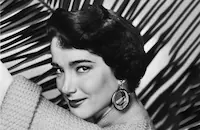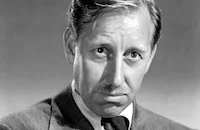Raymie
Brief Synopsis
Cast & Crew
Frank Mcdonald
David Ladd
Julie Adams
John Agar
Charles Winninger
Richard Arlen
Film Details
Technical Specs

Synopsis
On a Southern California pier, nine-year-old Raymie Boston watches as three fishermen lose their catches to Old Moe, a giant barracuda. The men suggest that whoever catches Old Moe will become an important figure on the pier, prompting Raymie to announce to the pier's manager, Mr. Garber, that he intends to catch the fish. After being warned to be careful by his mother Helen, a Korean War widow who works as a waitress at the pier's café, Raymie sets off to find sand crabs which he trades with Garber for a stronger fishing line. One of the fishermen, Rex Koontz, a cantankerous old man, is always complaining that Raymie gets in his way and tries to persuade Garber to ban him from the pier, but Ike Burrows, who has dated Helen, is impressed by the lad and encourages him to keep fishing. A pleasant old-timer, R. J. Parsons, gives Raymie tips on how to catch corbina to use as bait to land the barracuda, but warns him that Old Moe may just be a legend. One day while watching the men attempt to reel in a shark, Raymie falls into the ocean. After Ike dives in and saves him, Raymie asks Ike not to mention the incident to Helen. A few days later, at the café, Ike invites Helen on a second date but she is hesitant and wonders why he spends so much time at the pier. Although Ike explains that he works as a foreman for a construction company and that work is slow, Helen pleasantly declines his invitation. Later, Parsons tells Ike that Helen is interested only in a relationship with a steady, responsible man. The next day, Koontz offers to trade a corbina he has caught for Raymie's knife, but Raymie refuses, as the knife was his father's. Parsons then decides to help Raymie by trying to catch corbina with his expensive rod and line but suffers a heart attack in the process. After Raymie learns that Parsons has been giving his catch to Ransom, a café worker, to sell, Raymie promises to deliver Old Moe to him. When Raymie visits Parsons, the old man tells him that he is no longer well enough to fish and gives him all of his fishing tackle as a token of their friendship. However, Raymie has no luck in catching corbina and finally is forced to trade his knife for the fish. Later, when Raymie accidentally slaps Koontz in the face with a fish while swinging his rod, Koontz asks Garber to ban the boy from the pier. Alerted that Raymie is going to try to catch Old Moe that day, Parsons arrives in a wheelchair to watch and Raymie hugs him. Just after Garber arrives and tells Raymie that he will have to leave, Old Moe rises to Raymie's bait. Ike and the others help Raymie as he struggles to reel in the six-foot-long fish. Raymie suddenly feels sad, and realizing that Old Moe has become a friend, no longer wants him destroyed. As the fish weakens and Garber is about to shoot it, Raymie disrupts his aim, then uses Ike's knife to cut the line, thereby setting Old Moe free. The men, including Koontz and Garber, begin to understand Raymie's gesture and Ike makes Raymie a present of his knife. Helen then asks Ike for a date.

Director
Frank Mcdonald
Cast
David Ladd

Julie Adams

John Agar

Charles Winninger

Richard Arlen

Frank Ferguson
Ray Kellogg
John Damler
Jester Hairston
Vincent Padula
Ida Smeraldo
Christy Lynn
Brent Wolfson
Marianne Gaba
Shirley Garner
Leslie Glenn
Vance Skarstedt
Doak Roberts
Old Moe
Barbara Riley
Bill Catching
Crew
Sam Baker
Arthur Broidy
Ralph Butler
Leo Cornet
Henry Cronjager
E. E. Hanna
Mark Hanna
Judy Hart
Emile La Vigne
Madison Lacey
Harry Lewis
Max Luttenberg
A. C. Lyles
Edward Morey Jr.
Milt Olsen
Clark Paylow
Bette Rehm
Ronald Stein
Ronald Stein
Jimmie Stone
Burdicks S. Trask
Roger J. Weinberg
Jimmy West
George White

Film Details
Technical Specs

Articles
TCM Remembers - John Agar
Popular b-movie actor John Agar died April 7th at the age of 81. Agar is probably best known as the actor that married Shirley Temple in 1945 but he also appeared alongside John Wayne in several films. Agar soon became a fixture in such films as Tarantula (1955) and The Mole People (1956) and was a cult favorite ever since, something he took in good spirits and seemed to enjoy. In 1972, for instance, the fan magazine Famous Monsters of Filmland mistakenly ran his obituary, a piece that Agar would later happily autograph.
Agar was born January 31, 1921 in Chicago. He had been a sergeant in the Army Air Corps working as a physical trainer when he was hired in 1945 to escort 16-year-old Shirley Temple to a Hollywood party. Agar apparently knew Temple earlier since his sister was a classmate of Temple's. Despite the objections of Temple's mother the two became a couple and were married shortly after. Temple's producer David Selznick asked Agar if he wanted to act but he reportedly replied that one actor in the family was enough. Nevertheless, Selznick paid for acting lessons and signed Agar to a contract.
Agar's first film was the John Ford-directed Fort Apache (1948) also starring Temple. Agar and Temple also both appeared in Adventure in Baltimore (1949) and had a daughter in 1948 but were divorced the following year. Agar married again in 1951 which lasted until his wife's death in 2000. Agar worked in a string of Westerns and war films such as Sands of Iwo Jima (1949), Breakthrough (1950) and She Wore a Yellow Ribbon (1949). Later when pressed for money he began making the films that would establish his reputation beyond the gossip columns: Revenge of the Creature (1955), The Brain from Planet Arous (1957), Invisible Invaders (1959) and the mind-boggling Zontar, the Thing from Venus (1966). The roles became progressively smaller so Agar sold insurance and real estate on the side. When he appeared in the 1988 film Miracle Mile his dialogue supposedly included obscenities which Agar had always refused to use. He showed the director a way to do the scene without that language and that's how it was filmed.
By Lang Thompson
DUDLEY MOORE, 1935-2002
Award-winning actor, comedian and musician Dudley Moore died on March 27th at the age of 66. Moore first gained notice in his native England for ground-breaking stage and TV comedy before later building a Hollywood career. Like many of his peers, he had an amiable, open appeal that was balanced against a sharply satiric edge. Moore could play the confused innocent as well as the crafty schemer and tended to command attention wherever he appeared. Among his four marriages were two actresses: Tuesday Weld and Suzy Kendall.
Moore was born April 19, 1935 in London. As a child, he had a club foot later corrected by years of surgery that often left him recuperating in the hospital alongside critically wounded soldiers. Moore attended Oxford where he earned a degree in musical composition and met future collaborators Peter Cook, Jonathan Miller and Alan Bennett. The four formed the landmark comedy ensemble Beyond the Fringe. Though often merely labelled as a precursor to Monty Python's Flying Circus, Beyond the Fringe was instrumental in the marriage of the piercing, highly educated sense of humor cultivated by Oxbridge graduates to the modern mass media. In this case it was the revue stage and television where Beyond the Fringe first assaulted the astonished minds of Britons. Moore supplied the music and such songs as "The Sadder and Wiser Beaver," "Man Bites God" and "One Leg Too Few." (You can pick up a CD set with much of the stage show. Unfortunately for future historians the BBC commonly erased tapes at this period - why? - so many of the TV episodes are apparently gone forever.)
Moore's first feature film was the 1966 farce The Wrong Box (a Robert Louis Stevenson adaptation) but it was his collaboration with Peter Cook on Bedazzled (1967) that's endured. Unlike its tepid 2000 remake, the original Bedazzled is a wolverine-tough satire of mid-60s culture that hasn't aged a bit: viewers are still as likely to be appalled and entertained at the same time. Moore not only co-wrote the story with Cook but composed the score. Moore appeared in a few more films until starring in 10 (1979). Written and directed by Blake Edwards, this amiable comedy featured Moore (a last-minute replacement for George Segal) caught in a middle-aged crisis and proved popular with both audiences and critics. Moore's career took another turn when his role as a wealthy alcoholic who falls for the proverbial shop girl in Arthur (1981) snagged him an Oscar nomination as Best Actor and a Golden Globe win.
However Moore was never able to build on these successes. He starred in a passable remake of Preston Sturges' Unfaithfully Yours (1984), did another Blake Edwards romantic comedy of moderate interest called Micki + Maude (1984, also a Golden Globe winner for Moore), a misfired sequel to Arthur in 1988 and a few other little-seen films. The highlight of this period must certainly be the 1991 series Orchestra where Moore spars with the wonderfully crusty conductor Georg Solti and leads an orchestra of students in what's certainly some of the most delightful television ever made.
By Lang Thompson

TCM Remembers - John Agar
Quotes
Trivia
Notes
This film's working title was Raymie and the Barracuda. According to a August 10, 1959 Hollywood Reporter article, producer A.C. Lyles attempted to cast President Eisenhower's grandson David for the for the lead role of "Raymie Boston," but the boy's father, Maj. John Eisenhower, rejected the idea. The opening title states: "Filmed at California State Beach and Paradise Cove, California."














